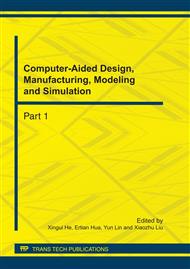p.718
p.723
p.730
p.735
p.741
p.746
p.750
p.755
p.759
Hybrid Experimental-Dynamical Modelling of Cutting Considering the Complex Chip Geometry
Abstract:
The introduced cutting model uses the widely applied mechanical-dynamical differential Lagrange model together with one of the most popular experimental force model (Kienzle-Victor model) in order to provide the more accurate demonstration and simulation of cutting processes. To increase the reliability of the results the authors considered as much parameters and as complex chip geometry as the calculations and processing made it possible. In this paper the sophisticated model of milling operation was the aim of the authors. The simulation results show good equivalency with the measured real cutting experiments. In spite of the complexity of the equations the rapid development in the informatics (hardware and software tools) helped the handling and quick calculation of the equations in this type of models.
Info:
Periodical:
Pages:
741-745
Citation:
Online since:
August 2011
Authors:
Keywords:
Price:
Сopyright:
© 2011 Trans Tech Publications Ltd. All Rights Reserved
Share:
Citation:


